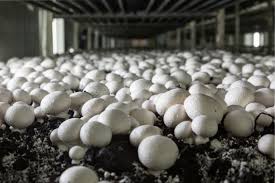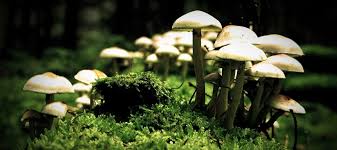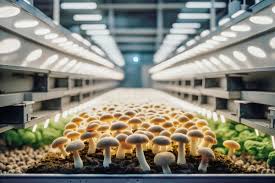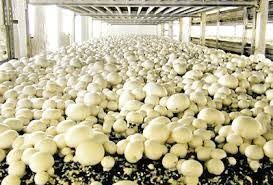Mushroom farming has gained immense popularity in recent years, thanks to its profitability and the increasing demand for gourmet and specialty mushrooms. The mushroom industry is one of the fastest-growing sectors in agriculture, driven by the rising awareness of the health benefits associated with mushrooms.
These fungi are not only rich in nutrients but also low in calories, making them an attractive food source for health-conscious consumers. As a result, profitable mushroom farming has become a viable business opportunity for both small-scale and commercial growers.
Mushrooms are versatile and can be used in various culinary dishes, from salads to soups and stir-fries. Their unique flavors and textures make them a favorite ingredient among chefs and home cooks alike. Additionally, mushrooms have gained popularity in the health food market due to their medicinal properties.
They are known for boosting the immune system, providing essential vitamins and minerals, and offering potential therapeutic benefits. This growing interest in mushrooms has led to an increase in their consumption, creating a lucrative market for mushroom farmers.
The startup costs for mushroom farming can be relatively low compared to other agricultural ventures. With a modest initial investment in equipment and materials, aspiring farmers can set up their operations.
Furthermore, mushrooms can be grown in various environments, including indoor facilities, greenhouses, and even small backyards. This adaptability allows farmers to maximize their production potential, catering to local markets and even larger distribution channels.
Different types of mushrooms can be cultivated, each with its unique characteristics and market demand. Some of the most popular varieties include button mushrooms, shiitake mushrooms, oyster mushrooms, and portobello mushrooms.
Each type has its growing requirements, but with proper research and planning, farmers can choose the variety that best suits their environment and market preferences. For instance, oyster mushrooms are known for their rapid growth and high yield, making them an excellent choice for beginners. On the other hand, shiitake mushrooms require specific conditions but offer higher profit margins, appealing to more experienced growers.
Profitable mushroom farming also provides opportunities for diversification. Farmers can expand their product offerings by growing various mushroom species or incorporating complementary products such as mushroom-based sauces, dried mushrooms, and even mushroom kits for home growers. This diversification can help farmers reduce risks associated with market fluctuations and enhance their overall profitability.
In addition to the financial benefits, mushroom farming can also contribute to sustainable agriculture. Mushrooms can be grown using agricultural waste products, such as straw, sawdust, and coffee grounds, which helps reduce waste and promote environmental sustainability. By implementing sustainable practices, farmers can attract environmentally conscious consumers who prioritize ethically produced food.
Profitable mushroom farming presents an exciting opportunity for individuals looking to enter the agricultural sector. With the rising demand for mushrooms, low startup costs, and potential for diversification, it is a venture that can yield significant financial returns.
As more people discover the nutritional benefits and culinary versatility of mushrooms, the market is expected to grow even further. For those willing to invest time and effort into learning the intricacies of mushroom cultivation, the rewards can be substantial.
Benefits of Mushroom Farming

1. High Nutritional Value: Mushrooms are packed with essential nutrients, including vitamins (like B vitamins), minerals (such as selenium and potassium), and antioxidants. They are low in calories and can be a valuable addition to a balanced diet, promoting overall health and wellness.
2. Economic Opportunities: Mushroom farming can be a profitable venture. The demand for mushrooms is growing, both in fresh and processed forms, making it a lucrative business for farmers. With relatively low startup costs and quick crop turnover, mushroom farming can provide a steady income stream.
3. Space Efficiency: Mushrooms can be grown in limited spaces, making them suitable for urban farming and small-scale operations. They can be cultivated indoors, outdoors, or in controlled environments, maximizing land use efficiency.
4. Environmental Sustainability: Mushroom cultivation is eco-friendly as it can utilize agricultural waste products, such as straw and sawdust, as substrates. This practice reduces waste and promotes sustainability in agriculture. Additionally, mushrooms contribute to soil health through nutrient cycling.
5. Pest Control: Mushrooms can be integrated into pest management systems. Certain mushroom species can deter pests naturally, reducing the need for chemical pesticides and promoting a healthier farming environment.
6. Versatility in Cooking: Mushrooms are versatile ingredients used in various cuisines around the world. They can be consumed fresh, dried, or processed, catering to diverse culinary needs and preferences.
7. Medicinal Properties: Some mushrooms possess medicinal qualities and are used in traditional medicine for their health benefits. Varieties like reishi and shiitake are known for their potential immune-boosting and anti-inflammatory properties.
Types of Mushrooms for Commercial Cultivation
1. Button Mushrooms (Agaricus bisporus): One of the most popular varieties, button mushrooms are widely consumed and can be cultivated easily. They are commonly found in grocery stores and are suitable for various dishes.
2. Shiitake Mushrooms (Lentinula edodes): Known for their rich flavor and health benefits, shiitake mushrooms are popular in Asian cuisine. They require specific growing conditions and are often cultivated on hardwood logs or sawdust blocks.
3. Oyster Mushrooms (Pleurotus ostreatus): These mushrooms are easy to grow and have a delicate flavor. They can be cultivated on a variety of substrates, including straw, coffee grounds, and cardboard.
4. Lion’s Mane Mushrooms (Hericium erinaceus): Recognized for their unique appearance and potential cognitive health benefits, lion’s mane mushrooms are gaining popularity. They can be grown on hardwood sawdust or other organic materials.
5. Portobello Mushrooms (Agaricus bisporus): A mature version of the button mushroom, portobello mushrooms are large, meaty, and often used as a meat substitute in vegetarian dishes.
6. Enoki Mushrooms (Flammulina velutipes): These long, thin mushrooms are popular in Asian cuisine. They grow well in cooler temperatures and are typically cultivated in low light conditions.
7. Maitake Mushrooms (Grifola frondosa): Known as “hen of the woods,” maitake mushrooms are prized for their flavor and potential health benefits. They grow at the base of oak trees and can be cultivated on various substrates.
Read Also: 14 Medicinal Health Benefits of Caltha palustris ( Marsh Marigold)
Understanding Mushroom Growth Requirements

1. Ideal Temperature: Different mushroom species have specific temperature requirements for optimal growth. Generally, most mushrooms thrive in temperatures ranging from 60°F to 75°F (15°C to 24°C). For instance, button mushrooms prefer cooler temperatures, while shiitake mushrooms can tolerate slightly warmer conditions.
2. Humidity Levels: High humidity is crucial for mushroom growth, as mushrooms require moisture to develop properly. The ideal humidity level is typically around 85% to 95%. Maintaining humidity can be achieved through regular misting or using humidifiers in controlled environments.
3. Ventilation: Proper airflow is essential to prevent the buildup of carbon dioxide and maintain healthy growth. Good ventilation helps in keeping humidity levels balanced and prevents diseases caused by stagnant air.
4. Light Requirements: While mushrooms do not require light for photosynthesis, certain light conditions can trigger fruiting. Indirect light is beneficial, particularly for species like shiitake and oyster mushrooms, as it helps develop their color and flavor.
5. Substrate Quality: The substrate, or growing medium, is vital for mushroom cultivation. Different species require specific substrates, which can include straw, sawdust, wood chips, or agricultural waste. Ensuring the substrate is properly sterilized before inoculation is critical to prevent contamination.
6. pH Levels: The pH of the substrate can affect mushroom growth. Most mushrooms prefer a pH range of 5.5 to 7.5. Regular monitoring and adjustment of pH levels may be necessary to create the ideal growing conditions.
7. Watering Practices: Maintaining adequate moisture levels in the substrate is essential. Overwatering can lead to contamination, while underwatering can inhibit growth. Regular monitoring of moisture levels helps in providing the right conditions for successful mushroom cultivation.
Selecting the Right Location for Your Mushroom Farm
1. Climate Considerations: The location should have a climate that supports the specific mushroom varieties you intend to grow. Most mushrooms thrive in moderate temperatures and humidity levels. Ideally, look for areas with average temperatures between 60°F to 75°F (15°C to 24°C) and a naturally high humidity level.
2. Accessibility: Choose a site that is easily accessible for transportation and supplies. This will facilitate the movement of materials, equipment, and harvested mushrooms, making your farming operation more efficient.
3. Proximity to Markets: Consider setting up your mushroom farm close to your target markets. Being near local restaurants, grocery stores, or farmers’ markets can reduce transportation costs and increase freshness, which is crucial for mushrooms.
4. Space Requirements: Ensure that the location has adequate space for your planned mushroom farming operation. Depending on the scale of production, you may need sufficient indoor space for cultivation and possibly outdoor areas for expansion or additional growing facilities.
5. Utilities and Infrastructure: Ensure the location has access to essential utilities such as water, electricity, and sewage disposal. These utilities are vital for maintaining optimal growing conditions and operating equipment like humidifiers and heaters.
6. Zoning and Regulations: Check local zoning laws and regulations related to agricultural activities. Ensure that mushroom farming is permitted in the area and familiarize yourself with any specific agricultural guidelines or requirements.
7. Environmental Conditions: Assess the surrounding environment for potential contaminants, such as pollution or pesticides from nearby farms. The ideal location should have a clean environment to ensure the quality and safety of your mushrooms.
Preparing the Growing Medium
1. Choosing the Right Substrate: The growing medium, or substrate, is critical for mushroom cultivation. Different mushroom varieties require specific substrates. Common options include straw, sawdust, wood chips, and agricultural byproducts. Select the substrate based on the mushroom species you plan to cultivate.
2. Sterilization: Proper sterilization of the substrate is essential to eliminate competing microorganisms. This can be achieved through methods such as steam sterilization, pressure cooking, or chemical sterilization. Ensure the substrate reaches the appropriate temperature for the required duration to kill pathogens and contaminants.
3. Moisture Content: After sterilization, maintain the correct moisture content in the substrate. Aim for a moisture level of around 60% to 70%. You can check this by squeezing a handful of the substrate—if water drips out, it’s too wet; if it crumbles, it’s too dry.
4. Nutrient Addition: Some substrates may benefit from the addition of nutrients to enhance mushroom growth. This can include supplements like bran, gypsum, or other organic materials. Ensure that any additives are compatible with the mushroom species being cultivated.
5. Inoculation: Once the substrate is prepared and cooled, inoculate it with mushroom spawn (mycelium). Spread the spawn evenly throughout the substrate to ensure even colonization. This step is crucial as it initiates the growth process.
Read Also: 11 Medicinal Health Benefits of Albizia julibrissin (The Persian Silk Tree)
Setting Up Your Mushroom Growing Environment

1. Temperature Control: Maintain the optimal temperature range for your chosen mushroom varieties. Use thermostats and heaters to ensure consistent temperature levels, as fluctuations can negatively impact growth.
2. Humidity Management: High humidity levels are essential for mushroom growth. Implement humidifiers or misting systems to maintain humidity levels around 85% to 95%. Regularly monitor humidity using hygrometers to make necessary adjustments.
3. Ventilation: Adequate ventilation is necessary to prevent the buildup of carbon dioxide and ensure a steady supply of fresh air. Design your growing environment with exhaust fans or air exchange systems to maintain proper airflow.
4. Lighting Conditions: While mushrooms do not require light for photosynthesis, certain light conditions can trigger fruiting. Use indirect light or fluorescent lights to provide a suitable environment for fruiting. Adjust light exposure based on the specific needs of the mushroom varieties.
5. Cleanliness and Sanitation: Maintain a clean growing environment to prevent contamination. Regularly clean and disinfect tools, equipment, and surfaces to minimize the risk of disease and pests. Establish a routine for cleanliness and sanitation practices.
Cultivation Techniques for Different Mushroom Varieties
1. Button Mushrooms (Agaricus bisporus): Growing conditions require temperatures of 55°F to 60°F (13°C to 16°C) and high humidity. Use composted manure as a substrate. Inoculate with spawn and cover with a layer of casing soil to retain moisture.
2. Shiitake Mushrooms (Lentinula edodes): They prefer temperatures of 60°F to 75°F (15°C to 24°C) with high humidity. Cultivated on hardwood logs or sawdust blocks. Inoculate logs with spawn and incubate in a shaded, humid environment.
3. Oyster Mushrooms (Pleurotus ostreatus): Thrive in temperatures of 60°F to 75°F (15°C to 24°C) and moderate humidity. They are cultivated on straw, coffee grounds, or cardboard. Inoculate the substrate and incubate in a dark, humid environment.
4. Lion’s Mane Mushrooms (Hericium erinaceus): Prefer temperatures of 60°F to 75°F (15°C to 24°C) and high humidity. Grown on hardwood sawdust or logs. Inoculate the substrate and maintain a humid environment to promote fruiting.
5. Portobello Mushrooms (Agaricus bisporus): Similar to button mushrooms, they require temperatures of 55°F to 60°F (13°C to 16°C) and high humidity. Grown on a composted substrate, typically under similar conditions to button mushrooms.
Pest and Disease Management in Mushroom Farming
1. Identification of Pests: Recognize common pests like fruit flies, mites, and nematodes that can harm mushrooms. Regular monitoring and visual inspections help in early detection.
2. Sanitation Practices: Maintain cleanliness in the growing area to prevent pest infestations. Regularly clean tools, surfaces, and equipment to eliminate any potential breeding grounds for pests.
3. Biological Control: Introduce beneficial insects like predatory mites or use natural pesticides to control pest populations without harming the mushrooms.
4. Environmental Control: Maintain optimal growing conditions (temperature, humidity) to reduce the likelihood of disease. Proper ventilation helps prevent the buildup of moisture, which can encourage mold and fungi growth.
5. Disease Management: Monitor for signs of diseases such as brown spot or white mold. Remove infected mushrooms and substrate immediately to prevent the spread of disease.
Harvesting Techniques for Maximum Yield
1. Timing the Harvest: Harvest mushrooms just before the caps fully open for maximum flavor and shelf life. Observe the maturity of the mushrooms for the best results.
2. Use of Proper Tools: Employ sharp, clean knives or scissors to cut the mushrooms at the base. This minimizes damage to the fruiting body and prevents bruising.
3. Gentle Handling: Handle harvested mushrooms carefully to avoid bruising and damage. Use baskets or containers that provide proper ventilation.
4. Clean Harvesting Area: Keep the harvesting area clean and organized to prevent contamination. This helps maintain the quality of the harvested mushrooms.
5. Post-Harvest Processing: After harvesting, promptly clean and package mushrooms for storage or sale. Proper post-harvest handling ensures freshness and extends shelf life.
Marketing Your Mushrooms Effectively
1. Identify Target Markets: Determine your target customers, which can include local restaurants, grocery stores, farmers’ markets, and individual consumers. Tailor your marketing strategies to meet their needs.
2. Develop a Brand: Create a recognizable brand that highlights the unique qualities of your mushrooms, such as organic certification or specialty varieties. This helps attract customers and builds loyalty.
3. Use Online Marketing: Utilize social media platforms and a dedicated website to showcase your mushrooms. Share recipes, growing tips, and customer testimonials to engage your audience.
4. Attend Local Events: Participate in farmers’ markets, food festivals, and community events to promote your mushrooms directly to consumers. Sampling can be an effective way to gain customers.
5. Build Partnerships: Collaborate with local chefs, restaurants, and health food stores. Establishing partnerships can lead to regular orders and increased visibility for your products.
Financial Considerations and Profitability Analysis
1. Initial Investment: Calculate the startup costs for mushroom farming, including equipment, growing medium, and spawn. Ensure you have a clear understanding of all expenses before starting.
2. Operational Costs: Monitor ongoing expenses such as labor, utilities, and maintenance. Keeping track of these costs is essential for accurate profitability analysis.
3. Pricing Strategy: Research market prices for different types of mushrooms to set competitive prices. Consider factors like quality, organic certification, and unique varieties.
4. Profit Margin Analysis: Regularly assess your profit margins by comparing total revenue against costs. This helps identify areas for improvement and adjust pricing or production strategies accordingly.
5. Financial Projections: Create detailed financial projections for the first few years of operation. Include anticipated sales, expenses, and profits to guide your business decisions and attract potential investors.
Do you have any questions, suggestions, or contributions? If so, please feel free to use the comment box below to share your thoughts. We also encourage you to kindly share this information with others who might benefit from it. Since we can’t reach everyone at once, we truly appreciate your help in spreading the word. Thank you so much for your support and for sharing!
Read Also: Product Concept Development and Evaluation






